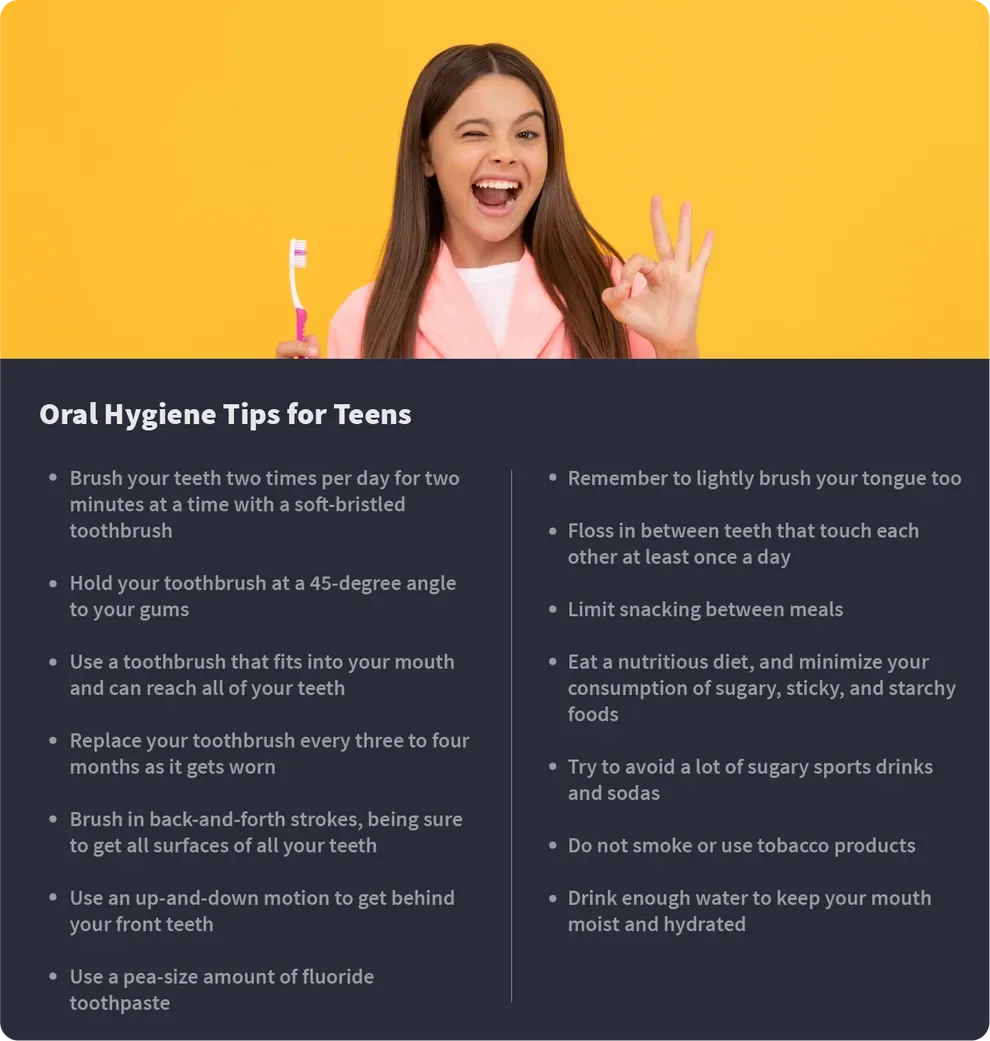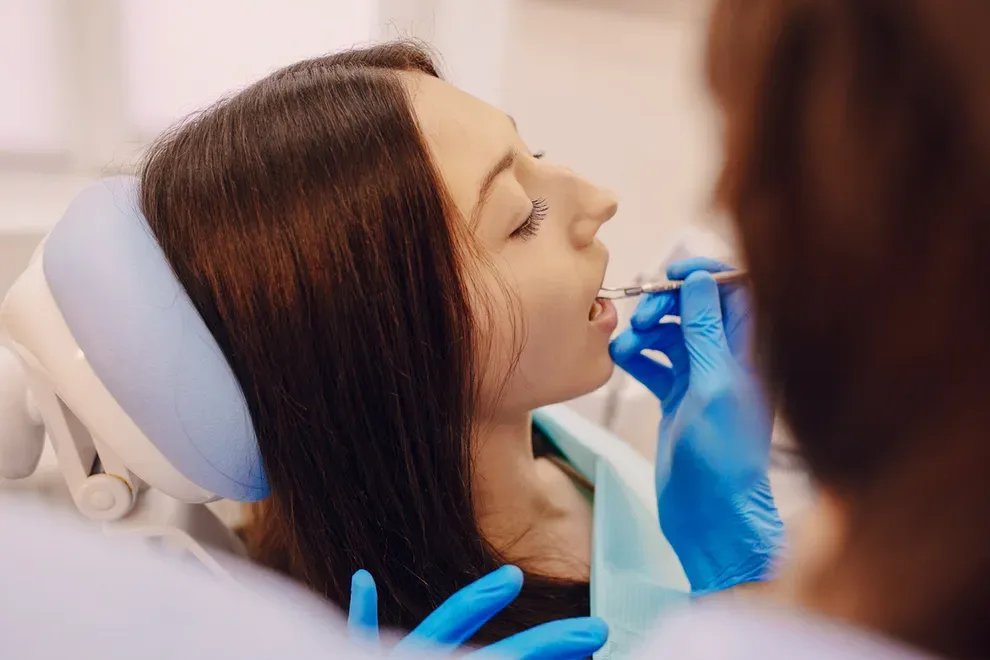Teen Oral Hygiene Guide
Table of Contents
- Oral Hygiene Tips for Teens
- Dental Checkups & Cleanings
- Sealants
- Protection for Teen Athletes
- Braces, Aligners & Retainers
- Wisdom Teeth
- Teeth Whitening Products & Safety for Teens
- Side Effects of Bad Oral Health Habits
- Best Toothbrushes & Toothpastes
Teen oral health is incredibly important. With calendars stacked with school, jobs, sports, and social lives, it can be easy for teens to toss oral hygiene to the wayside. It’s important to prioritize it.
Usually, by about age 12, the last baby tooth is lost and most (if not all) of the permanent teeth have arrived. It is important to take care of these permanent teeth, as they are the only ones you are going to get.
There are some simple things you can do to protect your teeth and mouth, setting yourself up for long-term success. Daily brushing and flossing are essential, and you should see your dentist for regularly scheduled check-ups and cleanings. Adolescence is also a typical time for orthodontic work, including braces, aligners, and retainers.
Wisdom teeth often come in or need to be removed in the teen years. Having these third molars checked out early to ensure they are coming in properly, or treating them if they are not, can minimize future complications.
There are many potential issues that can be the result of poor oral hygiene habits in the teen years, including tooth decay and gum disease. Brushing your teeth with the right kind of toothbrush and toothpaste can help to prevent future and current problems.
Ultimately, it’s important to stay on top of oral hygiene during the teen years. Doing so can save a lifetime of future troubles.

Oral Hygiene Tips for Teens
Good oral hygiene is essential for overall oral health. This means brushing and flossing daily as well as getting regular dental checkups.
We all know brushing and flossing your teeth can help to keep your smile bright and white. It can also help to minimize and even eliminate bad breath.
Here are some basic oral hygiene tips for teens:

Brush your teeth two times per day for two minutes at a time with a soft-bristled toothbrush.
Hold your toothbrush at a 45-degree angle to your gums.
Use a toothbrush that fits into your mouth and can reach all of your teeth.
Replace your toothbrush every three to four months as it gets worn.
Brush in back-and-forth strokes, being sure to get all surfaces of all your teeth. Use an up-and-down motion to get behind your front teeth.
Use a pea-size amount of fluoride toothpaste.
Remember to lightly brush your tongue too.
Floss in between teeth that touch each other every day.
Limit snacking between meals.
Eat a nutritious diet, and minimize your consumption of sugary, sticky, and starchy foods.
Try to avoid a lot of sugary sports drinks and sodas.
Do not smoke or use tobacco products.
Drink enough water to keep your mouth moist and hydrated.
It can be helpful to brush your teeth first thing in the morning when you wake up to remove harmful plaque and bacteria that can build up in your mouth overnight while you sleep.
If you drink coffee or orange juice with breakfast, you do not want to brush your teeth directly after, as the acids can interact with the toothpaste and actually weaken your enamel. In this case, it is often ideal to brush your teeth before breakfast.
Be sure to brush your teeth for two full minutes to get the best results. Setting up good brushing and flossing habits in adolescence can help you continue good oral hygiene throughout adulthood.
Routine Dental Checkups & Cleanings
Part of establishing a good oral hygiene routine is going to the dentist regularly. Your dentist can help you determine what is the best schedule for you. Most of the time, dentists recommend teens have a regular checkup and professional teeth cleaning every 6 to 12 months on average.
Teens are at a high risk for tooth decay and developing cavities. In fact, they are one of the highest risk age groups.
Good oral hygiene and regular dental checkups can help to minimize tooth decay and prevent cavities from forming. In the early stages of tooth decay, the enamel can repair itself, if the issue is caught and treated right away.
Later on, with more advanced tooth decay, the lost enamel cannot be repaired. Holes in the teeth (cavities) will have to be filled by a dental professional.
When you eat, acids in the foods interact with bacteria in your mouth, forming plaque on your teeth. Regular brushing and flossing help to remove this plaque. If the plaque remains on your teeth, it hardens into tartar, which can only be removed in a professional teeth cleaning.
Sealants
During a professional cleaning, the dentist can also apply sealants to your teeth. These can provide an extra layer of protection from decay and cavities.
It can be tough to reach all the surfaces of your teeth when brushing and flossing. Sealants can actually lower the risk for tooth decay by as much as 80 percent when applied to molars.
Sealants can be applied during a routine dental visit. It is a quick, safe, and easy procedure that can provide that extra level of protection for a few years.
Protection for Teen Athletes
If playing a contact sport, or a sport where there is a chance of being hit in the face or mouth, the American Academy of Pediatric Dentistry (AAPD) recommends wearing a properly fitted mouthguard. The mouthguard can prevent trauma and damage to the teeth, lips, tongue, and jawbone.
If you don’t wear a mouthguard during sports, you are 60 times more likely to damage your teeth than if you wear one. Mouthguards can be bought ready to wear, or they may be boiled and fitted to your mouth at home. Ideally, they are custom-made by your dentist
Braces, Aligners & Retainers
As your permanent teeth fill in during early adolescence, it can lead to some overcrowding or bite issues that require an orthodontic fix. It can be beneficial to have a consultation with an orthodontist after most of your permanent teeth are in, to determine if there are any corrections to be made.
Teens are often self-conscious about their appearance and smile. Orthodontic treatment can improve self-esteem and overall quality of life.
Orthodontics often include the use of braces, which realign your teeth through brackets and wires that apply pressure. Braces are readjusted every several weeks until the proper and desired bite is achieved.
Orthodontic treatment typically begins between the ages of 8 and 14. When applied while you are still growing, desired results can be more easily achieved.
Wisdom Teeth
Your wisdom teeth are your third molars. They generally erupt (come in) between the ages of 17 and 21.
Often, wisdom teeth are impacted, which means that they are trapped beneath the gum line or in the jawbone, and they are not going to come in normally. Sometimes, they come in improperly. There is often not enough room in your mouth for wisdom teeth.
In these cases, wisdom teeth are often removed by an oral surgeon. In order to assess whether they should be removed, your dentist will usually take x-rays to determine the placement and trajectory of your wisdom teeth.
If your wisdom teeth are removed, it generally takes about one to two weeks to heal completely. This is a common procedure that usually doesn’t involve complications.

Teeth Whitening Products & Safety for Teens
Soda, coffee, and tobacco products can stain your teeth. And teens are often worried about the appearance and color of their teeth.
There are several options when it comes to whitening your teeth, ranging from over-the-counter toothpastes, bleach solutions, and strips to in-office professional dental treatments. Dental teeth whitening is not recommended for children and young teens, as there can be variation between the coloring of baby and permanent teeth.
Once all of their permanent teeth are in and set, teens can choose to have a tooth whitening procedure done by a dental professional safely. The benefits of an in-office treatment include:
A professional exam that can determine the root cause of discolored teeth.
Protection of the soft tissue and controlled application of the bleach.
Faster results.
Attention to tooth sensitivity.
The ability to manage potential complications as they arise.
Most dentists do not recommend teeth whitening products or procedures prior to age 16. Teeth bleaching can be harsh on the teeth, gums, and mouth, and it can cause tooth sensitivity.
Side Effects of Bad Oral Health Habits
Poor oral hygiene, especially in the teenage years, can set you up for a lifetime of issues. If you do not take good care of your mouth and teeth, you run the risk of the following problems:
Tooth decay
Cavities
Gum disease
Tooth loss
Bad breath
Dry mouth
Tooth pain and sensitivity
Oral cancer
Infections and illness
It is important to refrain from smoking or using tobacco products. Also, steer clear of excessive alcohol consumption and recreational drugs. All of these products have negative impacts on mental and physical health and also on your oral health. Smoking, in particular, can raise your risk for gum disease, oral cancer, stained teeth, bad breath, and a dulled sense of taste and smell.
Another potential pitfall to avoid is damage from oral piercings. Piercings of the lips, tongue, or cheek can damage your teeth and gums, and cause sensitive or cracked teeth.
The Best Toothbrushes & Toothpastes for Teens
It is essential to use a toothbrush and toothpaste that are right for you and your mouth. Soft-bristled toothbrushes work well to remove plaque and not wear down your enamel.
You will also need to choose a toothbrush that can fit properly into your mouth. A toothbrush with a small head and a long neck can be ideal for reaching all your teeth with ease. You can use either an electric or manual toothbrush effectively.
Popular toothbrush brands that offer good options for teens include:
Oral B. With several different electric toothbrush models, including ones with wireless features and the Oral B Teen designed especially for teenagers, Oral B offers many different quality toothbrushes to choose from.
Philips Sonicare. One of the innovators in electric toothbrushes, Sonicare offers several electric toothbrush options in various price ranges, including models designed for children.
Consider these points when shopping for a toothbrush and toothpaste:
ADA Seal of Acceptance: When choosing a manual toothbrush, look for this seal. It means the toothbrush is approved by the ADA. Cross-soft bristled brushes are ideal.
Fluoride: Choose an adult toothpaste that is non-abrasive and contains fluoride. Popular brands include Colgate and Crest. Stay away from toothpastes targeted at kids that may be free of fluoride.
Remember that it is also important to floss daily. It can be beneficial to use a fluoride mouthwash as well.
If you’d like specific recommendations, ask your dentist. They know your mouth well and will be able to recommend the best dental products for you.
